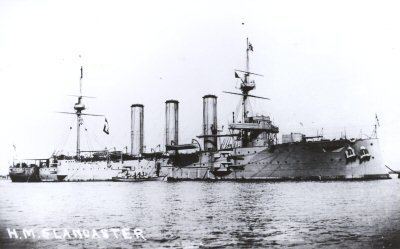Name HMS Lancaster Laid down 4 March 1901 Completed 5 April 1904 Launched 22 March 1902 Draft 7.6 m | Christened Mrs. Douglas Construction started 4 March 1901 Length 141 m | |
 | ||
Fate Sold for scrap, 3 March 1920 | ||
HMS Lancaster was one of 10 Monmouth-class armoured cruisers built for the Royal Navy in the first decade of the 20th century. Upon completion she was assigned to the 3rd Cruiser Squadron of the Mediterranean Fleet. She remained there until 1912 when she returned home to be placed in reserve. The ship was recommissioned in 1913 for service with the 4th Cruiser Squadron on the North America and West Indies Station. She remained there until she was assigned to the Grand Fleet in 1915. She was transferred to the Pacific in 1916 and she became flagship of the Eastern Squadron in 1918. The ship was sold for scrap in 1920.
Contents
Design and description
Lancaster was designed to displace 9,800 long tons (10,000 t). The ship had an overall length of 463 feet 6 inches (141.3 m), a beam of 66 feet (20.1 m) and a deep draught of 25 feet (7.6 m). She was powered by two 4-cylinder triple-expansion steam engines, each driving one shaft, which produced a total of 22,000 indicated horsepower (16,000 kW) designed to give a maximum speed of 23 knots (43 km/h; 26 mph). Lancaster, however, was one of two Monmouths that exceeded her designed speed; during her sea trials she reached 24 knots (44 km/h; 28 mph). The engines were powered by 31 Belleville boilers. She carried a maximum of 1,600 long tons (1,600 t) of coal and her complement consisted of 678 officers and enlisted men.
Her main armament consisted of fourteen breech-loading (BL) 6-inch Mk VII guns. Four of these guns were mounted in two twin-gun turrets, one each fore and aft of the superstructure and the others positioned in casemates amidships. Six of these were mounted on the main deck and were only usable in calm weather. They had a maximum range of approximately 12,200 yards (11,200 m) with their 100-pound (45 kg) shells. Ten quick-firing (QF) 12-pounder 12 cwt guns were fitted for defence against torpedo boats. Lancaster also carried three 3-pounder Hotchkiss guns and two submerged 18-inch torpedo tubes.
In 1915 Lancaster's main deck six-inch guns were moved to the upper deck and given gun shields. Their casemates were plated over to improve seakeeping. The twelve-pounder guns displaced by the transfer were repositioned elsewhere. At some point in the war, a pair of three-pounder anti-aircraft guns were installed on the upper deck.
The ship's waterline armour belt had a maximum thickness of four inches (102 mm) and was closed off by five-inch (127 mm) transverse bulkheads. The armour of the gun turrets and their barbettes was four inches thick while the casemate armour was five inches thick. The protective deck armour ranged in thickness from 0.75–2 inches (19–51 mm) and the conning tower was protected by ten inches (254 mm) of armour.
Construction and service
Lancaster, named for the English county, was laid down by Armstrong Whitworth at their shipyard in Elswick on 4 March 1901 and launched on 22 March 1902, when she was christened by Mrs. Douglas, wife of Vice-Admiral A. L. Douglas, Second Naval Lord. She was completed on 5 April 1904 and was initially assigned to the 3rd Cruiser Squadron of the Mediterranean Fleet. She remained with the squadron after it was redesignated as the 6th Cruiser Squadron, not returning home until 1912 when she was assigned to the reserve 5th Cruiser Squadron. The following year Lancaster was recommissioned and assigned to the 4th Cruiser Squadron on the North America and West Indies Station.
After the beginning of World War I in August 1914, she searched for German commerce raiders and protected convoys until she returned home to join the 7th Cruiser Squadron of the Grand Fleet in 1915. She was transferred to the Pacific in April 1916 and became flagship of the Eastern Squadron in 1918. Lancaster was partially dismantled in Birkenhead before she was sold for scrap on 3 March 1920 and subsequently broken up in Blyth.
